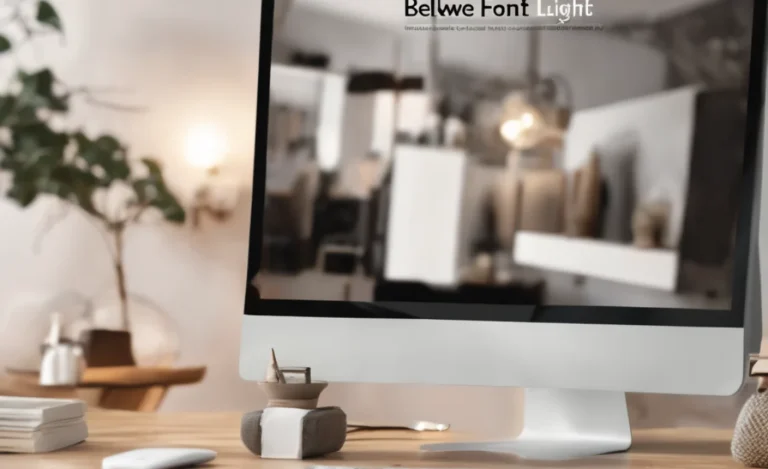Nirmala UI Font is a versatile, clear, and highly readable sans-serif typeface designed for user interfaces and digital content. It offers excellent legibility across various screen sizes and a modern, clean aesthetic, making it a go-to choice for designers seeking dependable and visually pleasing typography for their projects.
Creating visually appealing and easy-to-read digital content can sometimes feel like a puzzle. You want your words to stand out, but also be comfortable for your audience to read, whether they’re scrolling through a blog, navigating an app, or working on a presentation. Choosing the right font is key to unlocking this balance. If you’ve ever felt overwhelmed by font choices or struggled to find one that looks good everywhere, you’re not alone. Today, we’re diving into a font that simplifies this entire process: Nirmala UI. Let’s explore how this “essential design power” can elevate your next project.
What is Nirmala UI Font? A Deeper Look
Nirmala UI is a sans-serif typeface, meaning it doesn’t have the small decorative strokes (serifs) at the ends of its letters. This design choice inherently lends itself to cleaner, more modern looks, which is perfect for digital screens. Developed by Microsoft, Nirmala UI was specifically crafted with user interfaces (UIs) in mind. This means its design prioritizes clarity, readability, and a friendly, accessible feel – crucial elements when users interact with text on a screen for extended periods.
Think about the apps you use daily, the websites you browse, or even the operating system on your computer. Chances are, you’ve encountered Nirmala UI or fonts with a similar design philosophy. Its widespread availability and default inclusion in many operating systems, particularly Windows, have made it a familiar sight. However, its strength lies not just in its ubiquity but in its thoughtful design.
Key Characteristics of Nirmala UI
Nirmala UI isn’t just another sans-serif font; it’s built with specific design principles that make it stand out. Let’s break down what makes it so effective:
Exceptional Readability: This is Nirmala UI’s superpower. The letterforms are open and well-spaced, reducing the chance of characters blending together. This is crucial for small text sizes, long paragraphs, and busy interfaces.
Modern & Clean Aesthetic: Nirmala UI boasts a contemporary look that feels fresh and uncluttered. This aligns perfectly with current design trends that favor simplicity and functionality.
Versatile Weights: The font typically comes in a range of weights (like Light, Regular, Semibold, Bold), allowing designers to create clear visual hierarchy. You can use bold for headings and regular for body text, all within the same font family for a cohesive look.
Multilingual Support: A significant advantage of Nirmala UI is its extensive support for various languages and scripts. This makes it an invaluable tool for global projects. For instance, its Devanagari script support is noteworthy, making it a strong contender for projects targeting South Asian audiences. You can explore its character set and find more detailed technical specifications on reputable font resources.
Screen Optimization: Designed for digital displays, Nirmala UI renders beautifully on screens of all sizes, from tiny mobile notifications to large desktop monitors. It avoids common pixelation issues that can plague less optimized fonts.
Friendly & Approachable Tone: The slightly rounded terminals and open counters (the enclosed or partially enclosed negative space within a letter) give Nirmala UI a warm and approachable feel, making text feel less stern and more inviting.
Why is Nirmala UI Font a Design Powerhouse?
Font selection goes beyond just aesthetics; it impacts user experience, brand perception, and the overall effectiveness of your communication. Nirmala UI excels in several areas that make it a powerhouse for designers, marketers, and business owners alike.
1. Enhancing User Experience (UX) in Digital Interfaces
For anyone designing websites, apps, or software, user experience is paramount. If users struggle to read your content, they’ll likely leave. Nirmala UI directly addresses this by providing:
Crystal-Clear Navigation: Menu items, buttons, and labels need to be instantly recognizable. Nirmala UI’s clarity ensures users can quickly understand and click what they need.
Comfortable Long-Form Reading: Whether it’s an article, a product description, or documentation, Nirmala UI’s legibility reduces eye strain, keeping readers engaged.
Accessibility: A font that’s easy to read for everyone, including those with visual impairments, is fundamental. Nirmala UI’s design aids readability, contributing to more inclusive digital products. According to the Web Content Accessibility Guidelines (WCAG), clear typography is a vital aspect of web accessibility.
2. Building Strong Brand Identity
Your brand’s font is a silent ambassador. It communicates your values and personality. Nirmala UI can reinforce a brand identity that is:
Modern and Professional: Its clean lines convey competence and up-to-dateness.
Reliable and Trustworthy: The straightforward, no-fuss design inspires confidence.
Global and Inclusive: Due to its extensive language support, it’s ideal for brands with an international reach.
User-Centric: Using a font known for its readability signals that you prioritize your audience’s experience.
3. Streamlining the Design Process
For designers, particularly those working under tight deadlines or with limited resources, Nirmala UI offers significant advantages:
“Set it and Forget It” Reliability: Because it’s so versatile and readable, you can often implement Nirmala UI with confidence, knowing it will perform well across different contexts without extensive testing or tweaking.
Built-in Harmonization: Using a single font family, especially one with multiple weights, for headings, body text, and UI elements creates immediate visual consistency. This reduces the need to find and pair multiple fonts.
Ubiquitous Availability: As a standard font in many systems, you don’t have to worry as much about licensing or whether your client or their users will have access to the font file for proper rendering.
Where Can You Use Nirmala UI Font? Practical Applications
Nirmala UI’s flexibility means it can be applied in a surprisingly wide array of scenarios. Its design power truly shines when you understand its best use cases.
1. Website Design
Body Text: Nirmala UI is excellent for long articles, blog posts, and product descriptions. Its legibility keeps readers engaged.
Headings and Subheadings: Use its bolder weights to create clear hierarchy.
Navigation Menus: Ensure users can easily find their way around your site.
Buttons and Call-to-Actions: Clarity here is crucial for conversions.
2. Mobile App Development
User Interface Elements: Nirmala UI is a natural fit for labels, buttons, and input fields within apps.
Content Display: Perfect for displaying messages, notifications, or articles within an app.
3. Software Interface Design
Menus and Toolbars: Consistent and clear labeling enhances usability.
Dialog Boxes and Pop-ups: Important information needs to be easily digestible.
4. Presentations and Documents
Slide Titles and Body Content: Creates a professional and easy-to-follow presentation.
Reports and Proposals: Its clean look conveys seriousness and clarity. A report generator tool sometimes allows font selection, and Nirmala UI is a solid choice here.
5. Logos and Branding (with caution)
While Nirmala UI is primarily a UI font, its modern, clean aesthetic can work for minimalist logos for certain brands, especially tech startups or service-oriented businesses that want to convey approachability and reliability. However, for highly distinctive or creatively expressive brands, you might need to explore more unique display fonts.
6. Educational Materials
Textbooks and Worksheets: Readability is paramount for learning.
Online Courses: Ensure digital learning materials are accessible and easy to read.
Comparing Nirmala UI to Other Popular UI Fonts
To truly appreciate Nirmala UI’s design power, it helps to see how it stacks up against some other common contenders in the UI font space.
| Feature | Nirmala UI | Open Sans | Roboto | Lato |
| :——————- | :—————————————– | :————————————— | :—————————————- | :—————————————- |
| Primary Strength | Clarity, UI focus, Devanagari script support | Versatility, readability, friendly | Modern, geometric, excellent performance | Warm, stable, excellent legibility |
| Aesthetic | Clean, Modern, Approachable | Neutral, Open, Accessible | Geometric, Mechanical, Contemporary | Sincere, Friendly, Stable |
| Best Use Cases | UI Design, Apps, Global Content | Web Body Text, UI, General Use | Android UI, Web Body Text, UI | Web Body Text, UI, Logos |
| Weights Available| Multiple (e.g., Light, Regular, Bold) | Multiple | Multiple | Multiple |
| Multilingual | Excellent (incl. Devanagari) | Good | Very Good | Good |
| Feel | Dependable, Clear, Welcoming | Effortless, Trustworthy, Readable | Functional, Modern, Efficient | Honest, Solid, Readable |
As you can see, each font has its strengths. Nirmala UI carves out its niche with its exceptional clarity, screen optimization, and particularly strong support for non-Latin scripts, making it indispensable for international projects or designs targeting specific demographics.
Tips for Using Nirmala UI Effectively
Simply choosing a font is only half the battle. Implementing it well determines its true impact. Here are some tips to harness Nirmala UI’s design power:
1. Leverage Font Weights for Hierarchy
Don’t stick to just one weight. Use Nirmala UI’s variety to guide the reader’s eye.
H1/Main Titles: Use a bold or semibold weight.
H2/Section Titles: Use a semibold or regular weight, perhaps slightly larger.
Body Text: Use the regular weight for maximum readability.
Captions/Small Print: Use the regular weight, ensuring sufficient letter and line spacing.
2. Master Spacing (Kerning & Leading)
Even the best fonts benefit from good spacing.
Kerning: The space between specific letter pairs. Most applications do this automatically, but for headings, you might manually adjust critical pairs (like “VA” or “To”) for a polished look.
Leading (Line Spacing): Crucial for body text. Aim for line spacing that is about 1.5 times the font size. For example, if your text is 16px, try 24px line spacing. This prevents lines from feeling cramped.
3. Combine with Other Elements Thoughtfully
While Nirmala UI can work on its own for simplicity, sometimes pairing it can add personality.
For Headings: If you want a more decorative touch, you could pair a bold Nirmala UI heading with a more expressive display or script font for a very large hero title. However, ensure the overall contrast isn’t jarring.
Color Contrast: Ensure your text color has sufficient contrast with the background color. Tools like the WebAIM Contrast Checker can help you meet contrast ratio requirements for accessibility.
4. Test Across Devices and Screen Sizes
Even though Nirmala UI is screen-optimized, always preview your designs on various devices. What looks great on a desktop might need slight adjustments on a mobile phone. Check how text reflows and if elements remain clearly readable.
5. Consider the Tone of Your Project
Nirmala UI is generally neutral, modern, and friendly. It’s less suitable for projects demanding extreme formality, vintage aesthetics, or a highly artistic and expressive feel. If your brand is deeply rooted in tradition or whimsy, you might need a different font.
Common Pitfalls to Avoid
Even with a great font like Nirmala UI, designers can stumble. Here are a few mistakes to sidestep:
Overuse of Bold: Using bold for every sentence breaks readability and diminishes the impact of genuine emphasis.
Poor Line Spacing: Cramped lines of text are a major turn-off for readers.
Insufficient Contrast: Text that’s hard to read due to low contrast is simply inaccessible and unprofessional.
Trying to Be Too Creative: While Nirmala UI is clean, forcing it into contexts where a more decorative font is clearly called for can look out of place.
* Ignoring International Characters: If your project needs to support languages beyond English, ensure your chosen font (even Nirmala UI) has the necessary glyphs.
FAQ: Your Nirmala UI Font Questions Answered
| Question | Answer |
| Is Nirmala UI free to use? | Yes, Nirmala UI is a Microsoft product and is generally included with Windows operating systems. It’s also freely available for use in web design and development, particularly when using Microsoft’s design resources and CDNs. |
| Can I use Nirmala UI for my logo? | You can use Nirmala UI for a logo, especially if your brand aims for a clean, modern, and accessible feel. However, for a unique and distinctive brand identity, you might consider custom lettering or a more specialized display font. |
| What is Nirmala UI best suited for? | Nirmala UI is best suited for user interfaces (UIs), websites, mobile apps, software applications, and any digital content where clear readability across devices is essential. Its strong multilingual support also makes it excellent for global projects. |
| Does Nirmala UI support other languages? | Yes, Nirmala UI has excellent support for many languages, including a strong presence for Devanagari scripts (like Hindi and Marathi), making it highly valuable for multi-lingual projects. |
| How does Nirmala UI compare to Arial or Helvetica? | While Arial and Helvetica are classic sans-serifs, Nirmala UI is specifically optimized for screen rendering and often features more open letterforms for enhanced readability on digital displays. It also boasts better multilingual character sets for certain languages. |
| Where can I download Nirmala UI if it’s not on my system? | Nirmala UI is a system font with Windows. If you’re missing it or need it for a specific design tool or platform not running Windows, you can often find it included in Microsoft’s official design asset libraries or through reputable font repositories when available. For web use, Microsoft provides CDN links. |
| Can I use Nirmala UI in print? | Yes, Nirmala UI can be used in print, but it is primarily designed for screen use. For high-quality print materials, especially those requiring fine details or a specific gravitas, you might find other fonts more suitable. However, for everyday documents and reports, it performs perfectly well. |
Conclusion: Embrace the Clarity of Nirmala UI
In the bustling world of digital design, finding a reliable, readable, and versatile font can feel like discovering a hidden gem. Nirmala UI Font isn’t just another typeface; it’s a carefully crafted tool designed to make your content shine. Its focus on clarity, modern aesthetic, and exceptional screen performance makes it an invaluable asset for anyone creating websites, apps, presentations, or any digital product.
Whether you’re a seasoned graphic designer looking to streamline your workflow, a small business owner branding your online presence, or a beginner exploring the basics of typography, Nirmala UI offers a dependable foundation. By understanding its strengths and applying it thoughtfully, you can significantly enhance user experience, communicate your message effectively, and build a stronger, more accessible digital presence. So next time you’re faced with a font selection dilemma, remember the essential design power that Nirmala UI brings to the table. Its clarity is your command, and its versatility is your creative playground.






Leave a Comment